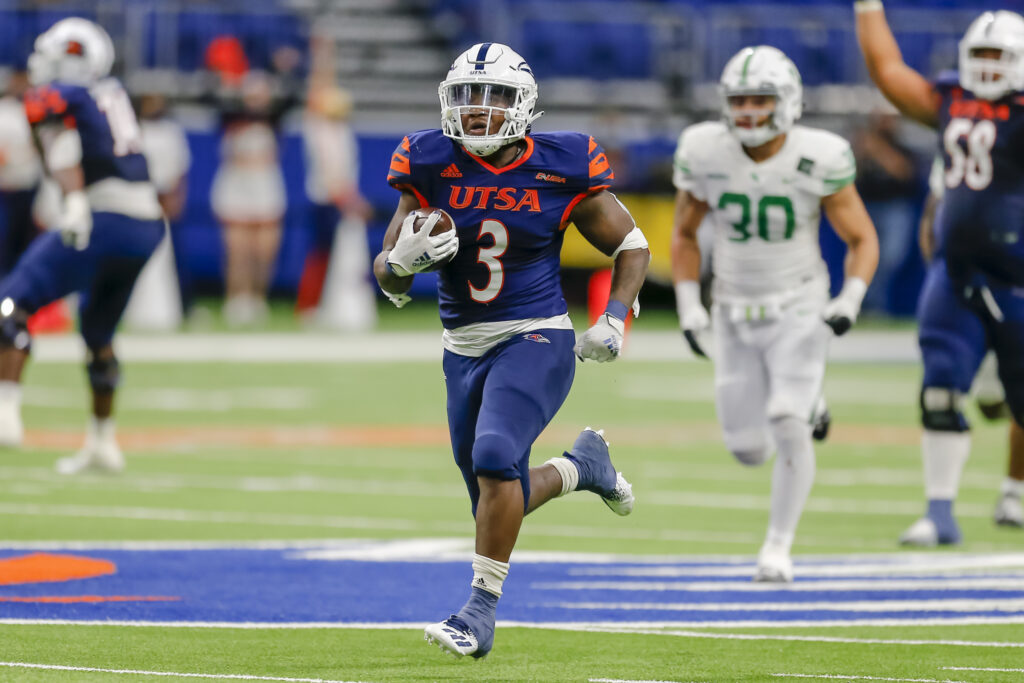This article is part of a series in which I evaluate 2022 rookie running backs solely on their ability to run the ball. The first installments can be found here. If you happened to already catch those and don’t need a refresher on my methodology, feel free to skip to the player-focused analysis below the picture of UTSA’s Sincere McCormick a couple paragraphs down.

Outside the ability of whoever happens to be running the ball, there is a whole mess of variables that factor into the effectiveness of a given rushing attack: scheme, play-calling tendencies, opponent strength and scheme, weather, offensive line play, surrounding skill-position talent, etc. And given this entanglement, separating the contributions of the ball carrier from the offensive environment in which he operates is not a straightforward task. My approach to doing that is centered around measuring the degree to which a running back is over- or under-performing the per-carry output of the other running backs on his team.
Starting from the premise that good runners do more with what they are given than do bad runners, it stands to reason that, provided players are operating under generally the same conditions (like, for example, playing on the same team), better backs should produce more per carry than lesser backs. Using this logic, we can establish a baseline for comparing efficiency between players on the same team; for each running back, we can compare his performance (X) to the collective performance of every other running back on the team (Y). If X > Y (essentially, if dude is doing more with his carries than his teammates are with theirs), we can probably conclude that the player in question is a good player, at least to some relative degree.
Assuming that this is a sound method of evaluating running backs relative to their teammates, we can then extend our comparisons to players from other teams (we’re really just creating a baseline for efficiency comparisons similar to how Dominator Rating and other market share-based metrics create baselines for volume-based comparisons).
The key metrics I use to evaluate running back performance vs. that of their teammates are called Yards Per Carry+, Chunk Rate+, and a metric I developed recently called Box-Adjusted Efficiency Rating, or BAE. I also like to use a metric called Breakaway Conversion Rate, but that is not a teammate-relative measure and we’ll therefore look into it separately.
The metrics are pretty straightforward: YPC+ is the degree to which a player over- or under-performs his teammates in yards per carry, and Chunk Rate+ is the degree to which a player over- or under-performs his teammates in rate of “chunk” runs (which I classify as runs of 10 yards or more). At a basic level, I want my running back prospects to find a way to produce more per carry than the other backs on the team, and part of that puzzle is navigating the line of scrimmage and extending runs into the secondary at a higher rate than his backfield mates. YPC+ and Chunk Rate+ measure the degree to which a player does both of these things.
BAE also does those things, but it improves upon Yards Per Carry+ by using a weighted average of a player’s per carry efficiency on carries vs. various amounts of defenders in the box (using data from Sports Info Solutions), relative to the per carry efficiency of other running backs on his team vs. the same box counts. The resulting percentage indicates to what degree a runner over- or under-performed his teammates on his total rushing attempts, relative to how often he faced each box count. BAE is a more comprehensive metric than is YPC+, and I will defer to it accordingly, but YPC+ and Chunk Rate+ will still be used given that the sample of data I have for those metrics goes back a decade-plus (while I’m only able to generate BAE Ratings going back to the 2018 college football season).
THE METRICS

Everybody wants to find the next small school superstar to lead their dynasty teams to the promised land. If you can properly identify an under-the-radar stud from outside the big boy conferences — like Matt Forte, Chris Johnson, or Aaron Jones — you can turn a low-capital investment into a top-level contributor to championships. Let’s see how UTSA Roadrunner Sincere McCormick stacks up:
I’ll start with the most positive thing I can find and say that McCormick was a really nice open-field runner throughout most of his college career. As an underclassman in 2019 and 2020, he turned 10-yard runs into 20-yard runs at a 45-percent clip, a rate that would be in the 96th-percentile among backs drafted since 2007. In 2021, he had a down year as far as creating big plays goes, and his career Breakaway Conversion Rate ended up at a very respectable 33.1-percent, a 63rd-percentile mark that puts him in the same range as guys like J.K. Dobbins and D’Andre Swift.
On the team-relative side of things, McCormick was slightly less impressive. His career mark in Yards Per Carry+ is a positive 0.59, as is his career Chunk Rate+ of 0.46-percent. But those numbers are in the 54th and 44th-percentiles, respectively. Considering the talent-level of the other UTSA runners, outdoing them to just a mediocre degree isn’t especially confidence-inducing. Those backfield teammates left high school rated an average of 2.60 stars, pedigree in just the 25th-percentile. To deflate the balloon even further, he posted those team-relative efficiency numbers while seeing box counts that were 0.12 defenders lighter on average than those his teammates were running against, the fourth-lowest relative count in this rookie class. Adjusting for those light box counts reveals that the average McCormick carry was worth 110.4-percent as much as the average carry from other Roadrunner backs, a BAE Rating in the 31st-percentile.
There’s not much question that McCormick was the best running back on his team, and he might have even been the best running back in his conference, but if I’m projecting small school runners to the NFL, being kinda nice isn’t good enough — they need to be absolutely dominant. Here’s his career rushing efficiency numbers next to those of some of the best Group of 5 conference ballcarriers in recent memory:

I don’t have Chunk Rate data available for guys whose college careers ended before 2010, but Matt Forte (2.01 YPC+), Ahmad Bradshaw (1.98), Chris Johnson (1.89), and DeAngelo Williams (1.01) also outdid their small school teammates to a greater degree than McCormick did his.
RUSHING EFFICIENCY SCORE AND COMPS
Sincere McCormick‘s composite Rushing Efficiency Score (which accounts for all the non-BAE metrics I’ve gone over here, in addition to overall team quality, strength of opponent, offensive line play, and carry volume) in my infallible running back model is a 49.0 out of 100, which is fairly blah. His score in a prototype composite based on box count-adjusted metrics is just a 37.0 out of 100, which would be the fourth-lowest score in the class. I just can’t get behind the idea that a guy who was simply pretty good relative to his Conference USA teammates is going to go the NFL and be anything close to pretty good relative to the best players in the world.
Using the same metrics that make up the composite Rushing Efficiency Score in addition to physical attributes like height, weight, and athletic testing numbers (we’ll assume McCormick is 5-9, 205-pounds, and runs a 4.50 forty), the comp machine finds these 10 players as most similar to McCormick as “pure runner” prospects:

This list is a who’s who of JAGs, and my hopes for McCormick are right along those lines. It’s conceivable that he has some sort of je ne sais quoi that makes him a quality prospect without any quantifiable evidence in support, but if that kinda guy hits, my simple response: oh well.
LAST WORD
Sincere McCormick was productive from an early age and that certainly counts for something, but unless it’s absolutely free, I don’t take shots on undersized running backs from small schools who weren’t dominant on the ground and who didn’t command a sizable role in their team’s passing game. Good luck to those of you who do.


